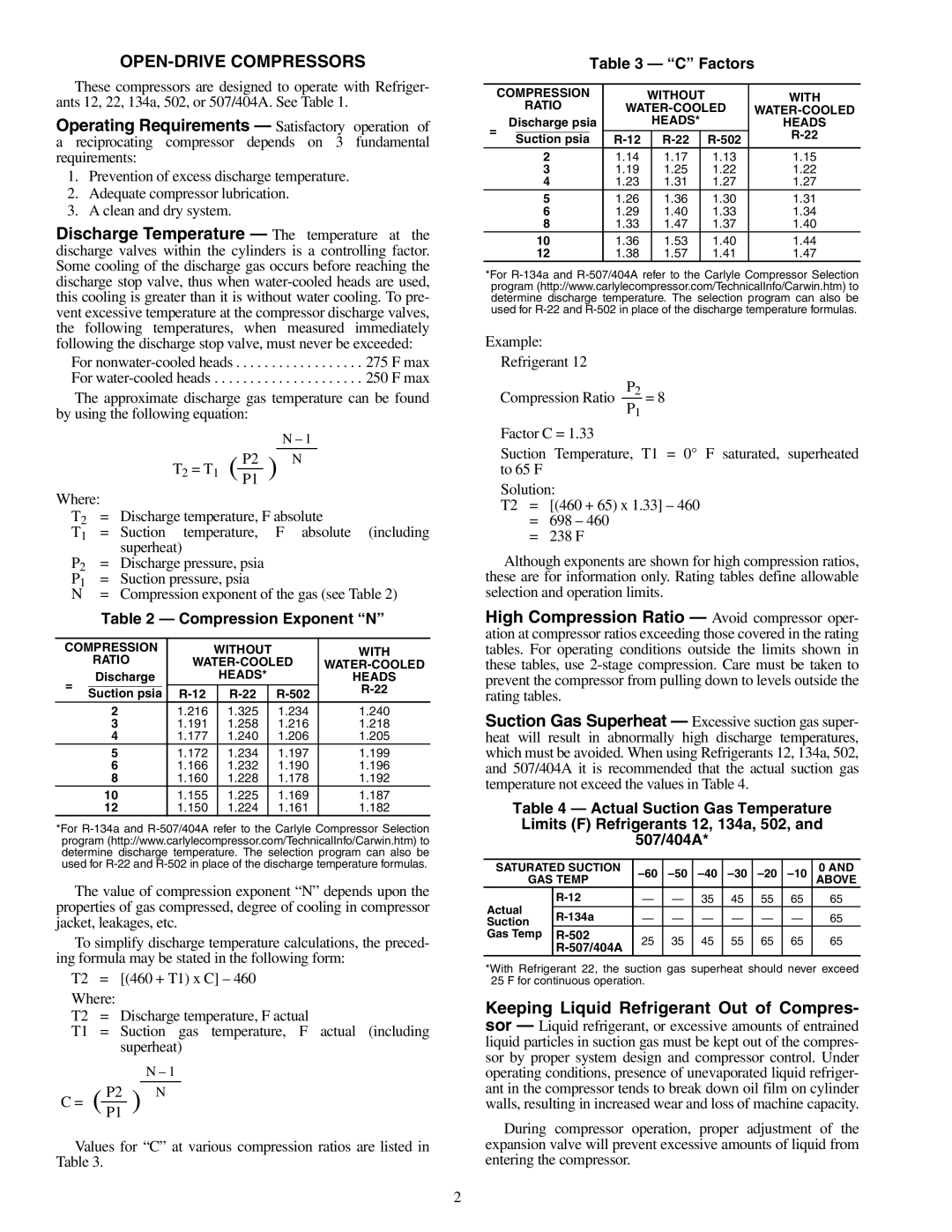OPEN-DRIVE COMPRESSORS
These compressors are designed to operate with Refriger- ants 12, 22, 134a, 502, or 507/404A. See Table 1.
Operating Requirements — Satisfactory operation of a reciprocating compressor depends on 3 fundamental requirements:
1.Prevention of excess discharge temperature.
2.Adequate compressor lubrication.
3.A clean and dry system.
Discharge Temperature — The temperature at the discharge valves within the cylinders is a controlling factor. Some cooling of the discharge gas occurs before reaching the discharge stop valve, thus when
For
The approximate discharge gas temperature can be found by using the following equation:
|
|
|
|
| N – 1 |
|
|
| T2 = T1 ( | P2 | ) N | ||
|
| P1 | ||||
Where: |
|
|
|
|
| |
T2 | = | Discharge temperature, F absolute | ||||
T1 | = | Suction temperature, F absolute (including | ||||
|
| superheat) | ||||
P2 | = | Discharge pressure, psia | ||||
P1 | = | Suction pressure, psia | ||||
N= Compression exponent of the gas (see Table 2)
Table 2 — Compression Exponent “N”
COMPRESSION |
|
| WITHOUT |
| WITH | |||
| RATIO |
|
| |||||
= | Discharge |
|
|
| HEADS* |
| HEADS | |
|
|
|
|
|
|
| ||
Suction psia |
|
| ||||||
|
|
| ||||||
|
|
|
| |||||
| 2 |
| 1.216 |
| 1.325 |
| 1.234 | 1.240 |
| 3 |
| 1.191 |
| 1.258 |
| 1.216 | 1.218 |
| 4 |
| 1.177 |
| 1.240 |
| 1.206 | 1.205 |
| 5 |
| 1.172 |
| 1.234 |
| 1.197 | 1.199 |
| 6 |
| 1.166 |
| 1.232 |
| 1.190 | 1.196 |
| 8 |
| 1.160 |
| 1.228 |
| 1.178 | 1.192 |
| 10 |
| 1.155 |
| 1.225 |
| 1.169 | 1.187 |
| 12 |
| 1.150 |
| 1.224 |
| 1.161 | 1.182 |
*For
The value of compression exponent “N” depends upon the properties of gas compressed, degree of cooling in compressor jacket, leakages, etc.
To simplify discharge temperature calculations, the preced- ing formula may be stated in the following form:
T2 | = [(460 + T1) x C] – 460 | |
Where: | ||
T2 | = | Discharge temperature, F actual |
T1 | = | Suction gas temperature, F actual (including |
|
| superheat) |
N – 1
( P2 ) N
C =
P1
Values for “C” at various compression ratios are listed in Table 3.
Table 3 — “C” Factors
COMPRESSION |
| WITHOUT |
| WITH | ||||
| RATIO | |||||||
= Discharge psia |
|
| HEADS* |
| HEADS | |||
| Suction psia |
|
| |||||
|
|
| ||||||
2 |
| 1.14 |
| 1.17 |
| 1.13 | 1.15 | |
3 |
| 1.19 |
| 1.25 |
| 1.22 | 1.22 | |
4 |
| 1.23 |
| 1.31 |
| 1.27 | 1.27 | |
5 |
| 1.26 |
| 1.36 |
| 1.30 | 1.31 | |
6 |
| 1.29 |
| 1.40 |
| 1.33 | 1.34 | |
8 |
| 1.33 |
| 1.47 |
| 1.37 | 1.40 | |
10 |
| 1.36 |
| 1.53 |
| 1.40 | 1.44 | |
12 |
| 1.38 |
| 1.57 |
| 1.41 | 1.47 | |
*For
Example: |
|
| |
Refrigerant 12 |
|
| |
Compression Ratio | P2 | = 8 | |
P | |||
|
| ||
| 1 |
|
Factor C = 1.33
Suction Temperature, T1 = 0° F saturated, superheated to 65 F
Solution:
T2 = [(460 + 65) x 1.33] – 460
=698 – 460
=238 F
Although exponents are shown for high compression ratios, these are for information only. Rating tables define allowable selection and operation limits.
High Compression Ratio — Avoid compressor oper- ation at compressor ratios exceeding those covered in the rating tables. For operating conditions outside the limits shown in these tables, use
Suction Gas Superheat — Excessive suction gas super- heat will result in abnormally high discharge temperatures, which must be avoided. When using Refrigerants 12, 134a, 502, and 507/404A it is recommended that the actual suction gas temperature not exceed the values in Table 4.
Table 4 — Actual Suction Gas Temperature
Limits (F) Refrigerants 12, 134a, 502, and
507/404A*
SATURATED SUCTION | 0 AND | ||||||||
GAS TEMP | ABOVE | ||||||||
Actual | — | — | 35 | 45 | 55 | 65 | 65 | ||
— | — | — | — | — | — | 65 | |||
Suction | |||||||||
Gas Temp |
| 25 | 35 | 45 | 55 | 65 | 65 | 65 | |
|
| ||||||||
|
|
|
|
|
|
|
| ||
*With Refrigerant 22, the suction gas superheat should never exceed 25 F for continuous operation.
Keeping Liquid Refrigerant Out of Compres- sor — Liquid refrigerant, or excessive amounts of entrained liquid particles in suction gas must be kept out of the compres- sor by proper system design and compressor control. Under operating conditions, presence of unevaporated liquid refriger- ant in the compressor tends to break down oil film on cylinder walls, resulting in increased wear and loss of machine capacity.
During compressor operation, proper adjustment of the expansion valve will prevent excessive amounts of liquid from entering the compressor.
2
